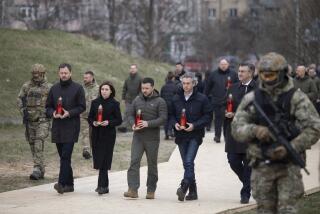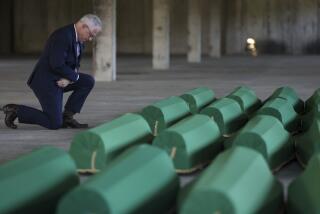Balkan Killing Fields Ignored, Activists Say
- Share via
DJULICI, Bosnia-Herzegovina — Nezad Avdic crept away from the stony killing field in this Serb-held village last summer with bullet wounds in his arm and stomach, and his heart in his throat.
The baby-faced high school student was left for dead in a heap of slaughtered Muslims who fled Srebrenica when the U.N.-protected town was overrun by Bosnian Serb soldiers in July.
“I was lying there when I felt a boot stop next to my head,” Avdic, 17, said in an interview. “The guy next to me was groaning in pain. I just closed my eyes and held my breath. They shot him. Then the guy with the boots went somewhere else.”
Avdic climbed past the corpses and eventually escaped to Muslim-controlled territory, where he is back in school. This week, six months after the summary execution of Srebrenica refugees across eastern Bosnia-Herzegovina, American troops began patrolling villages where survivors such as Avdic say up to 6,000 Muslims were massacred.
The scope of the Srebrenica horror set off an international outcry over what human rights groups characterize as the worst war crime in Europe since World War II.
These groups now complain that American peacekeepers, who they believe should be more concerned with rectifying the Srebrenica wrongs, are not looking for suspected grave sites to secure them as evidence for war crimes investigators.
“Human Rights Watch is deeply concerned by the apparent reluctance of some commanders within IFOR [the acronym for the NATO-led mission in the Balkans] to uphold a central part of IFOR’s mandate by providing necessary support to the international tribunal for the former Yugoslavia,” said a letter from the rights group sent to U.S. Adm. Leighton W. Smith, commander of NATO forces in Bosnia, on Friday. “We fear that unless IFOR gives heightened attention to the pursuit of justice, the peace process will be jeopardized.”
The Clinton administration has said it will protect war crimes investigators in the Balkans.
But one U.S. troop commander said that, while the Americans want to bring peace to Bosnia, their top priority is protecting American lives, not unearthing the horrors of the past four years.
“Right now that is a bridge too far for me to look at,” said Capt. Jeffrey Erron, commander of an American infantry troop that has been charged with keeping the peace in a large swath of Bosnia that includes several suspected mass graves.
“If I get to looking at things too far, who do I hurt?” he asked. “My soldiers.”
A senior military official in Tuzla, headquarters for the 20,000 American troops being deployed in Bosnia, said securing mass graves is not a military issue and falls outside the mandate of IFOR, or the Implementation Force of the North Atlantic Treaty Organization.
“IFOR has its hands full,” the official said. “Expansion of the mission is not something we are looking to do.”
The American military officials say the Srebrenica killing fields are a sensitive issue in the NATO deployment and if mishandled could poison relations with the Bosnian Serbs--who are accused of carrying out the mass slayings--and possibly endanger the lives of U.S. soldiers.
*
For troops on the ground, NATO policy has erased any practical distinction between a killing field and a cornfield.
“Unless a commander tells us otherwise, killing fields are not a reconnaissance objective,” said Capt. Bob Ivy, who heads an American infantry troop in the region.
American journalists who visited the rocky reservoir spillway here, where Avdic said he and untold others were shot, were hauled away this week by rifle-toting Bosnian Serb police and interrogated for four hours.
Police said the reservoir, a waste disposal site for an aluminum plant that has been out of operation since the war began, was a classified military installation.
American soldiers on Bradley fighting vehicles, meanwhile, rolled within half a mile of the guarded site.
“There is no military reason to go down there,” a senior U.S. military official said.
A large muddy expanse bordering the reservoir had mounds of freshly churned dirt, and a bulldozer with a backhoe--and mud in its treads--sat atop a dam above the spillway.
Journalists, who spent 15 minutes viewing the area before their arrest, found no evidence of bodies, but Muslim soldiers several miles away said they suspected the corpses were plowed into the reservoir, which contains a toxic brew of chemicals.
“About 4% of the waste dumped there is lime,” said one soldier who worked at the aluminum plant before the war. “It is so thick nothing would float.”
*
U.S. commanders who patrol this muddy farming town, as well as other villages with alleged killing fields, said they were not told about possible burial grounds, nor were they briefed about Srebrenica and the human carnage that followed its fall.
Soldiers said they have been provided with lists of destroyed churches, mosques, cemeteries and other culturally sensitive locations in their patrol areas as a precaution not to disturb them. They have not received similar warnings about the dozen or so suspected killing fields.
Human rights groups and Srebrenica survivors fear that such a narrow definition of peace enforcement has given Bosnian Serbs an opportunity to tamper with war crime evidence.
U.S. government officials, based on pictures taken by reconnaissance satellites and U-2 spy planes, alleged last fall that Bosnian Serbs poured corrosive chemicals on some Srebrenica victims and scattered the corpses of others that were buried in mass graves.
“If IFOR wants to make sure justice is done, step one is to secure these evidentiary sites,” said Kenneth Roth, executive director of Human Rights Watch, which has investigated war crimes in Bosnia. “Not only because justice is the lasting key to peace, but also justice is the key to the safety of IFOR troops.”
Hurem Suljic, 55, a bricklayer who says he survived a mass execution in a village near here by hiding beneath the corpses of his murdered friends, predicted that war will return to Bosnia if his captors, and others who committed atrocities, are not held accountable.
Suljic said he was rounded up near Srebrenica and taken to a school gymnasium near here, where he estimates 2,500 Muslims were packed shoulder to shoulder before being systematically slaughtered in nearby farmland.
Suljic said he saw hundreds of bodies in fields along the dirt road he traveled en route to his botched execution.
“If you want a field of wheat, you first have to clear the weeds,” said Suljic, who says he saw Bosnian Serb commander Gen. Ratko Mladic direct the killings on the grassy field where he survived. “IFOR knows how to create peace, and if they don’t want to do that, I don’t know why.”
A spokesman for the war crimes tribunal in The Hague, which is investigating atrocities in Bosnia, said a meeting will be held next week between tribunal and NATO officials to develop criteria for cooperation between the two organizations.
So far, no provisions have been made beyond assurances that NATO troops provide freedom of movement for investigators, as agreed last month by the Atlantic alliance, and assist in minor tasks when requested.
Even those pledges, however, will require several weeks to fulfill because NATO officials said they need time to complete deployment of the 60,000-strong peacekeeping force.
*
“We are working out the practical legal details and the ways of cooperation,” tribunal spokesman Christian Chartier said.
In Geneva on Friday, U.N. war crimes investigators said that they hope NATO-led troops will secure any suspected mass graves in Bosnia that could be evidence of a Bosnian Serb campaign of genocide against Muslims and Croats.
And in Washington, Defense Secretary William Perry said that once sufficient NATO forces are deployed to protect themselves, they would help provide security for investigators.
“If the war crimes tribunal wants to go to Srebrenica and dig up some graves, we’ll provide the security that allows them to do that,” Perry told the New York Times in today’s editions.
* RELATED STORIES: A8
More to Read
Sign up for Essential California
The most important California stories and recommendations in your inbox every morning.
You may occasionally receive promotional content from the Los Angeles Times.













